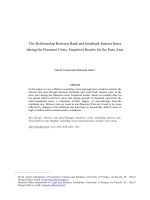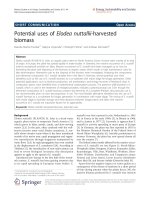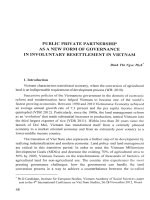Campra et al sovereign risk and public private partnership during the euro crisis (2014)
Bạn đang xem bản rút gọn của tài liệu. Xem và tải ngay bản đầy đủ của tài liệu tại đây (1.3 MB, 253 trang )
Sovereign Risk and Public-Private Partnership During the
Euro Crisis
Sovereign Risk and PublicPrivate Partnership During
the Euro Crisis
Maura Campra
University of Eastern Piedmont, Italy
Gianluca Oricchio
Bio-Medico University, Italy
Eugenio Mario Braja
University of Eastern Piedmont, Italy
and
Paolo Esposito
University of Eastern Piedmont, Italy
© Maura Campra, Gianluca Oricchio, Eugenio Mario Braja and Paolo Esposito 2014
All rights reserved. No reproduction, copy or transmission of this
publication may be made without written permission.
No portion of this publication may be reproduced, copied or transmitted
save with written permission or in accordance with the provisions of the
Copyright, Designs and Patents Act 1988, or under the terms of any licence
permitting limited copying issued by the Copyright Licensing Agency,
Saffron House, 6–10 Kirby Street, London EC1N 8TS.
Any person who does any unauthorized act in relation to this publication
may be liable to criminal prosecution and civil claims for damages.
The authors have asserted their rights to be identified as the authors of this work
in accordance with the Copyright, Designs and Patents Act 1988.
First published 2014 by
PALGRAVE MACMILLAN
Palgrave Macmillan in the UK is an imprint of Macmillan Publishers Limited,
registered in England, company number 785998, of Houndmills, Basingstoke,
Hampshire RG21 6XS.
Palgrave Macmillan in the US is a division of St Martin’s Press LLC,
175 Fifth Avenue, New York, NY 10010.
Palgrave Macmillan is the global academic imprint of the above companies
and has companies and representatives throughout the world.
Palgrave® and Macmillan® are registered trademarks in the United States,
the United Kingdom, Europe and other countries
ISBN: 978–1–137–39080–6
This book is printed on paper suitable for recycling and made from fully
managed and sustained forest sources. Logging, pulping and manufacturing
processes are expected to conform to the environmental regulations of the
country of origin.
A catalogue record for this book is available from the British Library.
Library of Congress Cataloging-in-Publication Data
Campra, Maura, 1961–
Sovereign risk and public-private partnership during the euro crisis / Maura
Campra, Gianluca Oricchio, Eugenio Mario Braja, Paolo Esposito.
pages cm
Includes bibliographical references and index.
ISBN 978–1–137–39080–6 (hardback)
1. Public-private sector cooperation – Europe. 2. Risk – Europe. 3. Debts,
Public – Europe. 4. Finance – Europe. 5. Financial crises – Europe. I. Title.
HD3861.E85C36 2014
338.8—dc23
2014024823
Contents
List of Illustrations
viii
List of Abbreviations
xi
1
Introduction
1
2
Sovereign Risk: Credit Risk Analysis and
the Role of PPP Schemes
2.1 Lessons learnt from the financial crisis: the strong
link between sovereign risk and bank risk
2.2 Sovereign and bank rating models
2.3 Sovereign risk and corporate risk: how to improve
the real economy
25
3
PPP Schemes
3.1
The genesis of PPPs
3.2
EU: no formal definition of PPP
3.3
PPP definition – form and substance
3.4
PPP in the European Commission Green Paper
3.5
PPP elements
3.6
Forms of PPP
3.7
PPP models and schemes
3.8
Elements of different PPP schemes
3.9
The PPP in Europe
3.10 Economic impacts in European countries
3.11 PFI model in the UK
27
27
30
32
35
36
36
37
42
42
49
53
4
IFRIC 12 Service Concession Arrangements
4.1
Introduction to IFRIC 12
4.2
Scope
4.3
Treatment of the operator’s rights over
the infrastructure
4.4
Recognition and measurement of arrangement
consideration
4.5
Recognition of consideration for construction
and upgrade services
54
54
55
v
4
4
6
60
62
65
vi
Contents
4.6
Management services, redeveloping infrastructure
functionality, financial charges
4.7
Recognition of elements made available by grantor
4.8
Classification of PPP sectors
4.9
Literature review: elaboration on the reference
theoretical framework
4.10 Implications of the Internal Stability Pact:
the Italian case
4.11 Appendix
5 Case Studies in UK: Energy Management, Transportation
Management, and Water Management
5.1
PPP in UK
5.2
Genesis of PPP in Europe: first forms
5.3
The instruments of popular participation in UK
5.4
The quantity, value of PPPs in the UK
5.5
Is value for money a priority in the UK?
5.6
Some UK examples under IFRIC 12 adoption
5.7
Appendix: the multi-business companies in
different PPP sectors in the UK
6 Italian Case Studies in Energy, Transport and
Water Management
6.1
A brief historical description
6.2
Italian complexity and regulatory confusion
6.3
The PPP in the public contract code
6.4
Italian contractual model
6.5
IFRIC 12 in Italy
6.6
The Italian statutory profile
6.7
Network of strategic infrastructure under concession
6.8
Public works concessions
6.9
PPP, SCA and IFRIC 12: a literature survey
6.10 IFRIC 12 in Italy
6.11 The energy sector
6.12 Transport sector: Italian railways
6.13 Transport sector: airports and infrastructure
6.14 Transport sector: highways
6.15 Water sector: regulation analysis
6.16 Appendix 6.1: effect on consolidated equity and
on net result
6.17 Appendix 6.2: typical case studies
74
76
77
78
79
82
86
86
90
90
94
96
100
105
115
115
115
116
117
118
119
120
124
125
126
132
135
143
146
148
151
153
Contents
vii
7 Case Studies in Spain (Energy, Transporation and
Water Management)
7.1 The Spanish experience of PPP
7.2 Why is the energy sector different in Spain?
7.3 Typical energy sector case studies
7.4 The transport sector
7.5 The water sector
7.6 Appendix: case studies
183
183
190
190
192
194
200
8 Sovereign Risk and PPP Schemes: Future Directions
208
Notes
217
Bibliography
220
Index
239
List of Illustrations
Boxes
3.1
5.1
Basic models of PPP
Generic factors driving value for money
41
99
Figures
2.1
2.2
2.3
2.4
2.5
2.6
2.7
2.8
3.1
3.2
3.3
3.4
3.5
3.6
3.7
4.1
5.1
5.2
Bank–sovereign–corporate risk relationship
Bank and sovereign risk are highly correlated
Main steps in developing a shadow rating model
Shadow accuracy ratio
Parent support PD adjustment
Government support PD adjustment
Bank capital buffers and lending growth
Credit crunch in EU peripheral countries
Contractual structure: project company
Evolution of PPPs in Europe for 1990–2009
PPP contracts in European transport sector (excluding UK),
number (top) and value (bottom)
Average size of PPP contracts by sector:
in the UK (top) and in
continental Europe (bottom)
Government investment expenditure as
a percentage of GDP
PPP contracts concluded in Europe between
2007 and 2009 in comparison to the average for
2001–2006, number (top) and value (bottom)
Evolution of PPPs in several European countries
between 2007 and 2009, compared with the 2001–2006
average, number (top) and value (bottom)
Concession services: right to charge in exchange
infrastructure construction services
PPP contracts in European transport sector
(excluding UK), number (top) and value (bottom)
Average size of PPP contracts by sector:
in the UK (top) and in
continental Europe (bottom)
viii
5
6
8
13
22
24
25
26
40
44
46
48
49
50
51
65
95
97
List of Illustrations
5.3
6.1
6.2
6.3
6.4
6.5
6.6
6.7
Evolution of PPPs in several European countries
between 2007 and 2009, compared with the 2001–2006
average, number (top) and value (bottom)
The evolution of PPPs (2002–2012)
The evolution of PPP contracts awarded (2002–2012)
Percentage value of PPP on Public Works (2002–2012)
Company structure: Ramo Milano
Ferrovie Nord Milan Group – social companies
Ferrovie Nord Milan Group – shareholders
Ferrovie Nord Milan Group – investments
ix
98
121
122
122
140
141
142
142
Tables
2.1
2.2
2.3
2.4
2.5
2.6
2.7
2.8
2.9
2.10
2.11
3.1
3.2
3.3
4.1
4.2
4.3
4.4
5.1
5.2
5.3
6.1
Methodological approaches
Calibration table for rating agency X
Quantitative and qualitative categories for a
country model long list
Developed countries – an illustrative rating model
Emerging countries – an illustrative rating model
Example of quantitative long list for bank rating models
Example of qualitative long list for bank rating models
An illustrative rating model for banks
in developed countries
An illustrative rating model for banks
in emerging countries
Parent positive and negative correction matrices
Government positive and negative correction matrices
PPPs – a European comparison
Normative references in the past 15 years
Elements of different PPP schemes
Objectives of the Internal Stability Pact since 2002
Summary relating to the type of data for
the calculation of cash, competence and
mixed competence
Reconstruction and classification of literature
Selected literature
Cost structure of privately financed roads
UK and Spain PPP framework
(Acerete, Stapleton, Stafford, 2007)
Comparison of accounting approaches
Normative references
7
9
11
16
17
18
19
20
21
23
24
33
35
43
80
80
83
85
103
104
106
117
x
List of Illustrations
6.2
6.3
6.4
6.5
7.1
7.2
8.1
8.2
Macro fields of PPP: number and amount
for categories counted in 2002,
2005, 2008–2012
Italian listed companies that have adopted IFRIC 12
Italian listed companies under IFRIC 12 adoption
IFRIC 12 effect on consolidated net result
PPP framework in Italy and Spain
Bidding models in PPP schemes
PPPs – a European comparison (Italy, UK, Spain)
UK, Italy and Spain PPP Framework
123
129
131
152
184
189
211
212
List of Abbreviations
AR
BOT
CGU
DBO
DBFO
ECB
EMS
ENAC
accuracy ratio
build operate transfer
cash generating unit
design build operate
design build finance and operate
European Central Bank
European Monetary System
Ente Nazionale Aviazione Civile (National Authority for Civil
Aviation)
GFS
government financial support
IASB
International Accounting Standards Board
IFRIC
International Financial Reporting Interpretations Committee
IFRS
International Financial Reporting Standards
IQ
investment quota
LLP
loan loss provision
LTIC
long-term infrastructure contracts
LTRO
longer-term refinancing operations
MoD
Ministry of Defence
NMS
New Member States
NPL
non-performing loans
NPS
National Policy Statements
NTG
(Italian) national transmission grid
O&M
operation and maintenance
OIC
Osservatorio Italiano Contabilità (Italian Accounting
Committee)
PA
public administration
PD
probability of default
PF
project financing
PFI
Private Finance Initiative
PPP
public-private partnership
PPPC
PPP contracts
PSC
Public Sector Comparator
PUs
public utilities
RFI
Rete Ferroviaria Italiana (Italian Railway Network)
ROSCO rolling stock company
xi
xii List of Abbreviations
RP
RTN
ranking power
Rete di Trasmissione Nazionale (Italian National Trasmission
Grid)
SAR
shadow accuracy ratio
SCA
service concession arrangement
SCDF
shadow cumulative default frequency
SIGAEC integrated environmental management, energy and indoor
environmental quality
VfM
value for money
1
Introduction
The financial crisis in Europe has led to a sharp increase in the levels
of both sovereign risk and banking risk. The high correlation between
sovereign risk and banking risk has produced a negative effect on the
general economic system in terms of (i) lower public expenditure,
(ii) less credit to corporates and SMEs and (iii) reduced private and public
investment.
Government bond issue restrictions in Euro-periphery countries have
also created negative effects on the real economy. The crisis has had
a strong impact on the initiation of new infrastructure and on investments on capital intensive initiatives. Direct public intervention in the
economy has declined.
At the same time, the ECB’s longer-term refinancing operations (LTRO)
programme has provided banks in the Euro Area with plenty of liquidity
and avoided possible bank defaults. However, this liquidity has not flowed
into the real economy, since the banks have invested it in either government bonds or bonds of their own (fixed income buy back).
The new Targeted Longer-Term Refinancing Operations (TLTRO) effectiveness must still be verified.
In the near future the Euro area’s main problem will be to avoid deflation. The ECB has an opportunity to follow the Federal Reserve, the
Bank of Japan and the Bank of England in applying quantitative easing
tools. Quantitative easing can be structured in (i) a government bond
buy programme, (ii) a private bond buy programme (on SME plain
vanilla Asset Backed Securities) or (iii) a modified LTRO programme
linked to new loans to corporates and SMEs. It is important not to lose
momentum, given the turning point in the Euro economy.
Governments cannot pursue Keynesian policies without increasing
their debt. However, we believe that public-private partnerships (PPPs)
1
2
Sovereign Risk and Public-Private Partnership During the Euro Crisis
would be a powerful tool (not yet fully implemented in the Europeriphery) in order to boost real economy without any pressure on
public debt and on sovereign risk.
PPPs, combined with other forms of credit mitigation or public support,
would make companies creditworthy enough for banks to finance them.
As a matter of fact, public-private partnerships usually have comparatively
modest capital requirements, according to Basel’s current regulations. In
this context, directing bank liquidity towards PPPs would produce a positive effect on the real economy and on public finance.
Through PPPs countries would fail to meet the need of creating new
infrastructure or investment or the need to develop innovative sectors,
for which the funds and the necessary resources would not be available
or for which the cost of procurement by the state would be excessive.
Therefore, it becomes very important to implement the construction
of public infrastructure in order to push bank liquidity towards investments with a lower degree of credit risk. A system of concessions to
private operators, in agreement with public operators, can realize and
manage the infrastructure until the concession expires. Therefore,
governments achieve the construction of infrastructure without charge,
relinquishing for a given period, short or long, any yields resulting from
its management.
The first part of this book focuses on the analysis and assessment of
sovereign and bank risks in the Eurozone and the United Kingdom (UK)
and examines the relationship between PPPs and the public debt ceiling
or sovereign rating in detail. Public companies wishing to receive benefit
from capital markets have to show investors that they are able to afford
the debt service and pay it back in accordance with the measures taken
and within the due date.
A key issue in the effectiveness of PPP schemes is risk management of
the timing and costs of execution. On the one hand the PPP is an excellent financing tool but, on the other hand, there is a substantial risk of
requests for revision and renegotiation of agreements by the dealers. If
PPPs are poorly managed the final cost to governments can be high.
In this context, the International Financial Reporting Interpretations
Committee 12 (IFRIC 12) on Service Concession Arrangements has taken a
fresh look at how PPP investments are represented and evaluated in the
financial statements of private entities. This examination by IFRIC 12 is
very important and represents a good starting point for a quantitative
analysis of PPPs.
The second part of this book analyses three countries (UK, Italy and
Spain) and the management of several utilities (energy, transportation
Introduction
3
and water) in order to find out how differently these countries cope with
these issues and which practices prove to be the best among the ones
put into action.
In the UK the Bank of England has used quantitative easing on a large
scale and there is a long experience of PPP schemes. The situation is
different in Spain and Italy, where there is not an extensive experience of
PPP schemes and the ECB has not yet applied quantitative easing tools.
An analysis of the legislation and national regulations on the subject
of concessions led us to identify a number of areas of activity covered by
these aspects. For each identified sector we analysed case studies drawn
from the most relevant operational realities in each country, selected as
part of the companies listed on regulated markets.
Our analysis showed that the highest concentrations of PPP activities
are developed in the following areas:
●
●
●
Transportation management (airports, railways, highways)
Energy management (gas, electricity, hydrocarbons, waste)
Water management
There are other industries with a high level of PPP activity, such as the
betting and gaming sector, which are not discussed this book.
We believe that in the near future the number of public-private partnerships will increase in the Euro area due to the constraints of both
internal stability pacts for public finance and the fiscal compact.
Italy and Spain are two out of a group of countries that need to activate PPP schemes in order to help their economic recovery; while the
UK is a country with an extensive use of PPP schemes and an economy
strongly supported by the Bank of England.
Although this book has been written with the joint contribution of all
the research group members, the chapters are to be attributed to the
following authors: Chapter 1: Maura Campra and Gianluca Oricchio;
Chapter 2: Gianluca Oricchio; Chapter 3: Paolo Esposito; Chapter 4:
Maura Campra; Chapter 5: Paolo Esposito; Chapter 6: From 6.1 to 6.10:
Paolo Esposito, and from 6.11 to 6.15: Eugenio Mario Braja (special
acknowledgement to Lucia Taruffo for her help in researching and
processing balance data in paragraph 6.11); Chapter 7: From 7.1 to 7.2
and 7.5 Paolo Esposito, and from 7.3 to 7.4 Eugenio Mario Braja; Chapter
8: Maura Campra and Gianluca Oricchio.
2
Sovereign Risk: Credit Risk Analysis
and the Role of PPP Schemes
2.1 Lessons learnt from the financial crisis: the strong link
between sovereign risk and bank risk
The financial crisis has brought to light a strong link between sovereign risk, bank risk and corporate risk. Initially, the crisis originated in
the banking sector and then spread so quickly it acquired sovereign risk
status, especially in majorly indebted countries, such as the periphery
countries to the euro zone (Figure 2.1).
As in a chain reaction, no sooner had the crisis flowed from the banking
system into financial markets than it instantly affected the real economy.
Since then, banks have been registering an unprecedented increase in
funding costs and capital absorption due to both the procyclical effects
of Basel’s regulations and a non-stop growth of non-performing loans.
Falling back on raising capital seemed to be much too dilutive a solution.
As a consequence, the main trend was towards “crunching the credit” by
restricting lending activities in the real economy, especially by reducing
assets in general, or risk-weighted assets in particular. That was like adding
fuel to the flames and triggered a downward economic spiral. So far,
ensuing business bankruptcies, layoffs and profit decreases have reduced
domestic demand and have had a negative impact on tax revenues and
national budgets. Just like the banks, heavily indebted economies on the
European periphery found it impossible to access financial markets in
order to increase their debt. Despite uncertainties, all enterprises were
nevertheless directed towards refinancing existing debt.
A link between bank credit risk and sovereign credit risk was established at once. Many banks have since stopped working correctly,
thus impeding the normal functioning of transmission mechanisms
of monetary policies. The relatively helpful rescue operations actually
4
Sovereign Risk: Credit Risk Analysis and the Role of PPP Schemes 5
Sovereigns
Banks
Figure 2.1
Corporates
Bank–sovereign–corporate risk relationship
Source: Our elaboration on the IMF Financial Stability Report, 2013.
overburdened national budgets and the cost of government bonds
reached (and sometimes exceeded) the margins of safety. Immediately,
an upswing in government bonds yield spread (measured as the difference between the yield of a government bond and the yield of a bond
offering the same duration) caused banks and companies to come to
terms with rising financing costs. The European Central Bank (ECB)
might have had to face a breakup of the euro zone. In accordance with
Basel’s regulations, the ECB decided to rescue the euro by saving the
banks in the first instance through a variety of tools aimed at expanding
the monetary base. Most importantly, for three years long-term refinancing operations (LTRO) provided the banks with the liquidity necessary (rated at one per cent) to survive independently of the financial
markets. As a result, banks in the euro zone periphery were easily able to
pay back their obligations and give way to bond buybacks, which should
have brought significant capital gains. However, rather than pouring
money into the real economy, the high liquidity introduced into the
banking system was mainly invested in the acquisition of government
bonds, deemed to be not only less risky but also more remunerative
than investing in companies. This tendency started a carry trade which
did not prevent national economies of the European periphery from
defaulting. It also did not help the real economy to recover. How memorable is the ECB president’s pledge to do “whatever it takes” to preserve
the euro and price stability.
Current events have been characterized by a strong connection
between sovereign rating and bank rating: considerable upswings
in the value of bank stocks are directly proportional to downturns
in the government bond spread, and vice versa. It follows then that
sovereign risk must be analysed and discussed jointly with bank risk
(Figure 2.2).
6
Sovereign Risk and Public-Private Partnership During the Euro Crisis
Sovereigns
Banks
Corporates
Figure 2.2 Bank-Sovereign-Corporate Risk Relationship: Bank and sovereign risk
are highly correlated
Source: Our elaboration on the IMF Financial Stability Report, 2013.
The relationship between sovereign risk and bank risk is analysed in the
next section that look at a fundamental analysis of sovereign and bank
rating models.
2.2
Sovereign and bank rating models
There are three main methodologies which can be used to develop a PD
model, as summarized in Table 2.1 and as illustrated here below:
●
●
●
good/bad analysis, applied principally to SME corporate and retail
segments;
pure expert ranking method, used typically for the development of
large corporate models;
shadow rating approach, specific to segments characterized by a
limited number of defaults, but distinguished/differentiated as those
given an official rating by an external agency (such as Standard &
Poor, Moody or Fitch).
The most statistically robust method is the good/bad analysis, where
factors can be tested for how they predict actual default patterns and an
optimal combination of factors and modules can be found to predict the
value of the binomial variable: “did the party default in the following
12 months?”
This methodology requires a significant number of default data
points for the analysis to be valid. This makes the analysis inappropriate for bank and country segments, since not enough default data
are available.
Sovereign Risk: Credit Risk Analysis and the Role of PPP Schemes 7
Table 2.1
Methodological approaches
Good/bad
Development
Validation
Data
Discriminatory
power
Pure expert
ranking
Shadow rating
Prediction of the
Selection and
Mimic external
(binary) default event
weighting of
ratings
factors based on
expert judgement
Preferably through
logistic regression;
alternatively,
multivariate
discriminate analysis
and neutral networks
Test on out of sample
Comparison to
expert judgement
of results
Alternatively, cross
Compared to
validation
bond ratings or
good/bad data, if
available
At development: at
At development:
least 30 defaults per
none
explanatory variable
At validation: a
At validation: at least
representative
10% of development
sample of
sample for holdout
sample; none for
counterparts
cross validation
Highest discriminatory Highly dependent
power possible
on the quality of
expert judgement
Danger of overfitting
Typically not better
than Statistical
methods
Linear regression
against PDs of
external ratings
Out of sample
Compared against
good/bad data, if
available
At development:
at least 100 rated
counterparts
At validation: at
least 50 rated
counterparts
Good
discriminatory
power
Limited by the
quality of
External rating
Where good/bad analysis cannot be used, shadow (bond) methodology offers a less robust but statistically valid alternative. It uses a
factor’s ability to predict default modelled on a proxy by measuring its
ability to forecast an external rating agency’s predicted default rate.
The analysis is based on the probability of default that corresponds
to the bank’s (or country’s) external ratings, according to a calibration
table that associates each agency’s rating grade to a precise probability
of default (see Table 2.1).
If two or more external ratings are available for the same enterprise
(e.g. Moody, Standard & Poor and/or Fitch), the final PD is an average
between the available PDs.
8
Sovereign Risk and Public-Private Partnership During the Euro Crisis
STEP 1
Portfolio analysis,
definitions,
methodological
approach, model
structure
Figure 2.3
STEP 2
Sample
selection,
external rating
gathering,
variable
identification
STEP 3
Univariate
analyses
STEP 4
Multivariate
analyses
STEP 5
Calibration,
model testing
STEP 6
IT
implementation,
roll-out in the
banking
processes
Main steps in developing a shadow rating model
A shadow rating model aims to replicate external ratings by using
both quantitative (financial for banks, macroeconomic or financial for
countries) and qualitative factors (extracted from questionnaires filled
in by internal credit analysts).
In this case, also, the univariate analysis tests the forecasting capability
of a factor’s long list; the selected ones (medium list) will be successively
transformed and put in relation to each other by means of a multivariate
regression that will determine the subset of final variables (short list)
designed to constitute the forecasting model.
Once the weights and final factors have been defined one proceeds
with the calibration curve that will assign the score computed by the
regression for a default probability.
The calibration curve will be determined by means of statistical analysis techniques directed to maximizing the fit with the initial PDs, so
that the credit class assigned by the model to the single sample entity
will not differ more than one or two notch(es) from that determined by
the external rating.
In Figure 2.3 the main steps for the development of a shadow rating
model are illustrated; in the two following Paragraphs we will examine
exclusively the aspects which make this typology of models different
from the traditional ones, based on the approach good/bad, extensively
described in Chapter 2 to which the reader can refer to complete the
treatment.
2.2.1
Country rating model
The credit risk relative to a sovereign is composed of two factors: the
“sovereign risk” and the “transfer risk”.
The sovereign risk refers to the likelihood of default by the country counterparty, while the transfer risk is relative to the unlikelihood of collecting
the granted credit from a counterparty resident in a foreign country. Both
aspects will have to be taken into account when building a model.
Sovereign Risk: Credit Risk Analysis and the Role of PPP Schemes 9
2.2.1.1
Step 1: portfolio, definitions, methodology and model structure
As the chosen methodological approach is a kind of shadow rating, the
first selection criterion for indentifying the development sample(s) is
the existence of at least one external rating (from Moody, Standard &
Poor, Fitch etc.) assigned to the selected counterparty.
To increase the statistical and economic relevance of the model(s) it
is appropriate to group the countries in mostly homogeneous sub-segments (according to the economic development level, political considerations, etc.) and then proceed to the construction of distinct models for
each sub-segment. As an example, one can assume the need to build two
distinct models: the first for developed countries, the other for emerging
countries.
2.2.1.2
Step 2: developing samples and data
If large portfolios are present, it is recommended that the selected development sample comes from outside the an external rating, according to
a physical criterion: countries with a limit (of short or medium period)1
greater than a given amount.
Then, assign to each country an external rating standardized by proper
calibration tables (based on the link between each agency rating grade
and a probability of default).
In Table 2.2, as an illustrative example, a possible calibration of the
external agency X is shown; the table permits to compare the rating
assigned by the agency X with the one expressed by the agency Y
Table 2.2 Calibration table for the
rating agency X
Rating grade PD of rating agency X
1
2
3
4
5
6
7
8
9
10
11
12
0.01%
0.03%
0.07%
0.12%
0.24%
0.40%
0.70%
1.20%
3.50%
6.10%
10.5%
20.0%
10 Sovereign Risk and Public-Private Partnership During the Euro Crisis
transformed, in turn, into default probability – obviously, with respect
to the same default definition between the to considered Agencies.
When two or more different external ratings are available for the same
counterparty (e.g. Moody, Standard & Poor and/or Fitch), an average of
the available PDs is calculated according to the formula:
PDexternal =
1 n
⋅ ∑ PDi ,
n i =1
where n (n ≥ 1) is the number of external available PDs (for the considered counterparty), while PDi is the default probability assigned to the
i-esime external agency.
As the objective of an internal rating model is to estimate the default
probability up to one year from the time of the counterparty evaluation
by means of the available data, to the macroeconomic and qualitative
factors relative to the year t, when developing, should be associated to
the external PDs relative to the year t + 1.
In general, for countries in the development sample, it is necessary to
use data from two years before the date of default (for bad counterparts)
or of the forecast (for good counterparts).
A one-year time lag is caused by the fact that the model has to estimate a one-year default frequency; moreover, it is assumed that one year
before the default (forecast) only the data from the year before is available, this causes the whole time lag to be two years.
A list of macroeconomic or financial and qualitative factors which
could be expected to be predictors of default, and hence used by
rating agencies to predict the probability of default, should be drawn
up.
Then the quantitative and qualitative factors have to be classified into
different categories to test different aspects. The main purpose of this
categorization is to provide a structure when defining and working with
the factor list (the so-called long list). Ideally, the final model should
contain a broad representation from across the categories, with no two
factors containing similar information.
Table 2.3 illustrates the categorization of quantitative and qualitative
factors for a country’s rating model.
While the quantitative factors could be acquired from an external
provider, qualitative factors need to be gathered through a qualitative
questionnaire drawn up by an internal expert.
Sovereign Risk: Credit Risk Analysis and the Role of PPP Schemes 11
Table 2.3
long list
Quantitative and qualitative categories for a country model
Quantitative category
Qualitative category
Banking system
Current account
Debt
Government finance
Growth
Liquidity
Monetary Policy
Structure
Debt servicing record
Economic conditions
Foreign relations
Quality and stability of the financial system
Social and political conditions
Because the qualitative elements are, by their nature subjective, to ensure
their objectivity and consistency it is very important that:
●
●
every question is given a grade on a scale where answers are ordered
by good (factor value 1) to bad (factor value 5);
to ensure consistency in assigning these grades among different
experts, each question is supplemented with a guideline.
2.2.1.3
Step 3: univariate analyses
For high-default portfolios the first step in determining the optimal
combination of quantitative or qualitative factors is to analyse each
factor individually.
This step has three main purposes:
●
●
●
●
data cleaning
identification and removal of outliers (in this case, quantitative
factors only)
(quantitative) factor transformation and normalization, so that they
are set to the same scale, where outliers are given less weight and
scores have the same average and standard deviation.
measurement of the predictive power of the factors on a standalone
basis
The first three points in the list above are substantially equal to the ones
already described in this chapter. But in the absence of a good/bad state, for
the measurement of the predictive power of a standalone factor, or of the
module score, it is necessary to adopt an adjusted accuracy ratio measure.
12 Sovereign Risk and Public-Private Partnership During the Euro Crisis
2.2.1.3.1 The shadow accuracy ratio (SAR)
In relation to the traditional accuracy ratio (AR), for the evaluation
of the rank ordering power, in a shadow rating approach framework
the first step consists of computing the ranking power (RP), where the
shadow cumulative default frequency (SCDF), represented on the y-axis
in Figure 2.4 is calculated as:
SCDF1 =
PDexternal , 1
n
∑ PD
external , j
j =1
PDexternal , i
SCDFi = SCDFi −1 +
n
∑ PDexternal , j
,
for i = 2, ..., n.
j =1
where n is the number of sample conterparts.
By computing the shadow default rate (SDR) as:
n
∑ PD
external , j
SDR =
j =1
n
,
it is possible to determine the B area depicted in Figure 2.4 and then the
model ranking power (RPmodel) as:
RPmode l =
Area (A)
.
Area (A) + Area (B )
In the shadow rating approach the ideal model, which orders the counterparts in the best possible way, is the one defined by the same external
agency’s PDs and has a forecasting power lower than 100 per cent (see
in Figure 2.4).
To obtain a value of the examined model’s accuracy ratio, which is more
comparable with the one computed with the standard approach (good/
bad sample based), it is necessary to correct the examined model’s ranking
power with the ranking capability of the ideal, that is the one that exactly
replicates the external agency’s judgement, using the formula:
SAR = SAR mod el =
RPmod el
.
RPshadow rating









